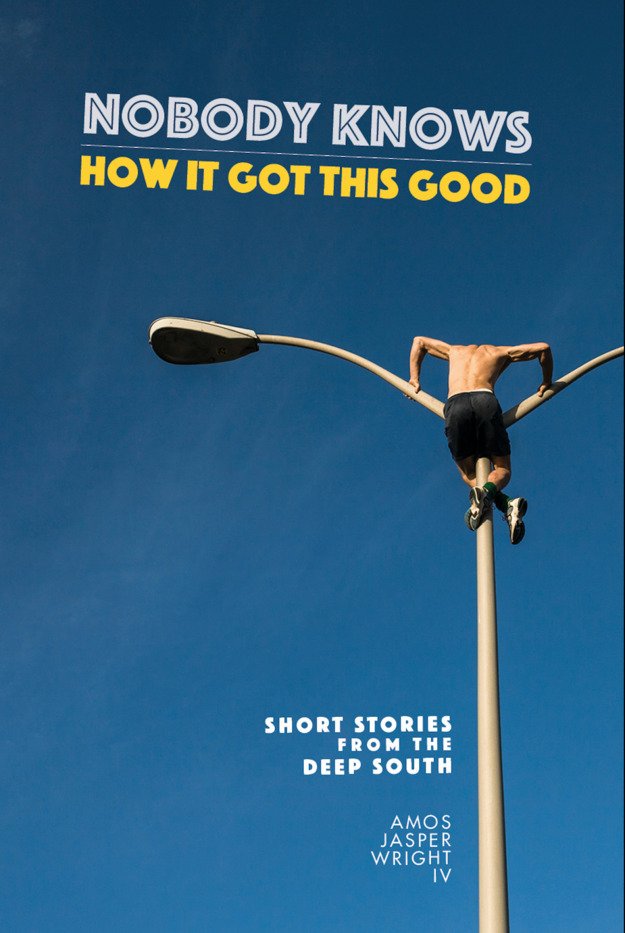Originating in Experience: A Conversation with Amos Jasper Wright IV
Amos Jasper Wright IV, author of the short story collection Nobody Knows How It Got This Good, is back with a wonderful novel, Petrochemical Nocturne. It was a pleasure to be able to talk to Amos about his writing. In our conversation, we discuss the constraints of form, experimentation in literature, and, of course, his latest release:
Bradley Sides: Let’s dive right in, Amos. I am always interested in talking to authors who have written and published in shorter and in longer forms, and you’ve done just that. Do you feel like one was easier—or maybe more natural—for you to put together?
Amos Jasper Wright IV: Maybe paradoxically, in the beginning, short stories were more difficult for me, probably because of their brevity and the constraints of the form, and my first literary efforts, mercifully buried in hard drives and forgotten, were novels, or at least novelistic. Stories demand a certain authorial restraint, a process of selection and filtering, tactical precision and strategies of omission. Stories can be more like poems in this regard, finely tuned machines. Novels are more forgiving than stories, it’s easier to hide blemishes or get away with shoddy sentences in a baggy narrative of 300,000 words than it is in 8,000 words. In a story, those bad sentences will show and they will poison the surrounding text. On a purely practical level, it’s easier to edit a story, or even a collection of stories, than a novel; the totality of a story can be held whole in the mind, whereas a novel’s structure gets lost in the vastitude of it all, at least in my noggin.
As you probably noticed, I tend towards the verbose, so cranking out 300,000 words or more for a novel is a cinch, although preventing that verbal discharge from being formless is the challenge. Being succinct does not come naturally to me, and I certainly wouldn’t be the first Southern writer (whatever that means) to suffer from the prolix malady (you know who you are). Most of my stories are at least 12,000 words, and many are 20,000. I’m currently sitting on an unpublished manuscript of more than 500,000 words – stopping was the hard part. It could’ve been longer. Maybe this is logorrhea, maybe it’s a lack of discipline, maybe some stories just need half a million words to be told, but it comes naturally.
Bradley: What do you see as the relationship between your previous collection, Nobody Knows How It Got This Good, and your new novel, Petrochemical Nocturne?
Amos: Given the nature of the business, the order of publishing and the order of production do not always align in a sequential or linear way. Nobody Knows How It Got This Good was written more than a decade ago now, and there have been many unpublished projects between Nobody Knows and Petrochemical Nocturne, which may or may not ever be published, and so the delayed order of publication can create the illusion of more continuity than there really is. That said, the stories do share many of the same thematic preoccupations, such as our petrochemical culture, which is most obviously dramatized in the Deepwater Horizon story in Nobody Knows How It Got This Good. Nobody Knows was, I think, more comical too; Petrochemical Nocturne, while it has playful or funny moments, is a fundamentally darker story.
Bradley: I made several notes about how your stories and your novel both evoke place pretty heavily, specifically the American South. Is this something you think about as you begin to write or does place just kind of find its way in your work naturally?
Amos: Yes, some might say too heavily. As a Southerner, place oozes from your chromosomes, it’s in your bloodstream. But in terms of the writing process itself, or creating a place-based atmosphere, in general place isn’t something I have to think about too much, especially in the initial stages of composition. For Southern writers, a strong sense of place is our inheritance, whether you want it or not, while also avoiding the lazy tropes, or tired images of evening cicadas and moonlight on magnolias and dripping Spanish moss and all the regional stage set design, although I am probably guilty of this myself, and as it turns out, cicadas and magnolias are part of the place. However, relying on this precognitive inheritance can only take you so far. There are moments in Petrochemical Nocturne where evocations of place demand a technical knowledge of environmental systems, geological history, hydrology, organic chemistry, and other less impressionistic oozings, and the union of these – the technical and the impressionistic – is where interesting synergies take place, or so I tell myself. Lately, in an attempt to exorcise the South and test myself, purge the regional inheritance from my system, I have been working on projects, short fiction and novels, that are not set in the South, and obsess over other preoccupations, such as economics, business, and finance.
Bradley: Another feature of your novel I made several notes regarding is how you describe the environment. I’ll pull from one of the earliest mentions. You write, “Down at the levee earlier that day, where I sometimes go to contemplate the polymorphic biographies of the river, I alone saw the petrochemical epiphenomena of things unseen: the strangely colored toxic chlorine clouds in chartreuse and dead salmon or moribund, putrid cantaloupe, the hazmat clouds merging into a coherent sentient mass of chlorine gas ghost ships sailing downriver on Fisk’s myriad Mississippis.” It’s a vivid, strong description that feels so very true and personal to me. It comes from somewhere real, right? Something you’ve seen? Read?
Amos: Almost everything in the novel, even though it is fiction, originates in experience. When I lived in Baton Rouge, walking to the levee and the Mississippi River was routine. I’d watch the tugboats maneuver and the steam clouds from the cooling towers drift over the river. Most of these florid passages are an amalgam of direct observation overlaid with some homecooked fabulism. Although I struggled with the ethics of aestheticizing this poisoned and poisonous landscape, which has ruined entire communities, maybe it was a way of salvaging something from the ruins; and I mean ruins quite literally – you drive around parts of south Louisiana and it’s like the aftermath of an industrial experiment that has gone horribly wrong. It’s the end of the world out there on Airline Highway and River Road. In spite of our best efforts to maximize profits out of the landscape, there remain some beautiful passages up and down the river. But as Greek myth teaches, the beautiful and the poisonous are not mutually exclusive categories. Despite the photos accompanying the text, this is not an empirical report.
Bradley: This is maybe an odd kind of question, but do you see the environment as being a character in Petrochemical Nocturne?
Amos: The environment in the South, and especially south Louisiana, is very much a character. It has personality, attitude, moods and mood swings, it can be violent and/or beautiful, it can be sad and melancholy, or exultant and jubilant. If not treated with respect, the environment will destroy you. In Petrochemical Nocturne the environment is a sort of totalizing Leviathan. In one sense, the environment overwhelms the characters, obliterates them, a story as old as time, to be found in the Old Testament or the Odyssey. The difference is that there were no petrochemical plants in those days. Although I am reluctant to frame this as a binary battle between man and environment, in which the environment always wins, in this case, the story is about how man’s character, as a species that irreparably alters and degrades the environment down to the molecular level, has turned the environment against him, and in some ways that makes us a homeless animal. Landscapes like Cancer Alley are largely synthetic, manmade reflections of our values and worldview. These petrochemical monsters are products of the human mind – what does that tell us about ourselves? What kind of animal does it take to look at a river and say, “You know what this river needs – a petrochemical plant!”
Bradley: I really admire experimentation with literary forms. Here, in Petrochemical Nocturne, you use several visual images to give your narrative added layers. For example, there are photos, paintings, and maps. Will you talk a bit about why you included these images—what they give the work?
Amos: I’ve long had an interest in the visual arts, and at one time dabbled in painting, and wanted to be a sculptor. Maybe the use of these visual aids is the flailing nostalgia of a failed artist. As far as the maps are concerned, I’ve also had an interest in historical cartography, and regularly use mapping and GIS in my professional W-2 work. The novel’s Toxmap, for example, was an actual mapping tool that I used at work. I considered making some of my own maps, but decided that the novel required the real thing. Hopefully without using these visuals as a crutch, the photos and maps lend the narrative a documentary veneer, fictionalized events and lives corroborated with historical records such census data or battlefield photography. There’s a strange and eerie quality to some of the novel’s otherwise traumatic photos. Conversely, the historical record and the bygone events documented in the photos are given flesh and blood in the contemporary characters. In our world of “fake news” and “alternative facts,” they complexify the fictional narrative, reminders that while the narrator and Toussaint may be fictional, Whipper Peter was a real man, his absent tormentors implied by the scars on his back.
Bradley: Before I let you go, I want to briefly ask about the historical elements inside your book. Did you find the inclusion of these to ever be limiting in how far the “fiction” could go? Or did the foundation in history—and people and events of history—help the novel find its way?
Amos: That’s a valid point. I never experienced them as constraints, though that does not mean that they’re not constraining. Without that historical ballast, it’s possible my maximalist storytelling mode would send the narrative into deep space. Constraints can be liberating, the historical armature provides some structure and grounding. Given my thematic preoccupations, I don’t know how you set a novel in a historically fraught place like south Louisiana and ignore the local history; not that you have to write a narrative as saturated in it as Petrochemical Nocturne, but some level of acknowledgment seems in order. To your point, my more recent writing projects have more or less dispensed with this historical mode, at the same time that I’ve been exorcising the South from my repertoire, at least for now. I’m sure the South will eventually return to haunt me again.
Bradley: Thank you for your time, Amos. You’ve written a timely and thoughtful book, and I enjoyed being able to spend time with it.
Amos Jasper Wright IV is from Alabama. His first short story collection, Nobody Knows How It Got This Good, was published by Livingston Press (University of West Alabama) and his first novel, Petrochemical Nocturne, was published in 2023 by Livingston Press. He recently completed several as yet unpublished books - The Battle of Danziger Bridge, In the Land of the Blind, and The Empire of Repetitive Motions - and is currently working on a novel about the 2007-2008 financial crisis and retail stock trading.



